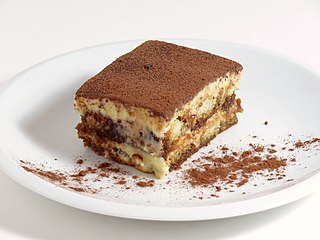
Tiramisu is an Italian dessert made of ladyfinger pastries dipped in coffee, layered with a whipped mixture of egg yolks, sugar, and mascarpone, and flavoured with cocoa powder. The recipe has been adapted into many varieties of cakes and other desserts. Its origin is disputed between the Italian regions of Veneto and Friuli-Venezia Giulia. The name comes from the Italian tirami su.
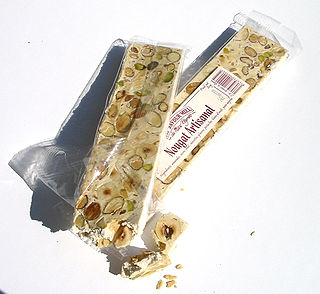
Nougat is a family of confections made with sugar or honey, roasted nuts, whipped egg whites, and sometimes chopped candied fruit. The consistency of nougat is chewy, and it is used in a variety of candy bars and chocolates. The word nougat comes from Occitan nogat, which means 'nutted' or 'nutty'.
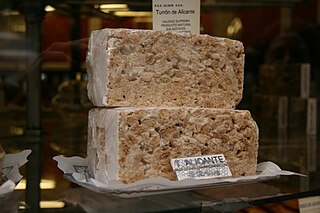
Turrón, torró or torrone is a Mediterranean nougat confection, typically made of honey, sugar, and egg white, with toasted almonds or other nuts, and usually shaped either into a rectangular tablet or a round cake. Turrón is usually eaten as a dessert food around Christmas in Spain and Italy. In Malta it is sold in street stalls as qubbajd during the parish patron saint feast of the various localities.
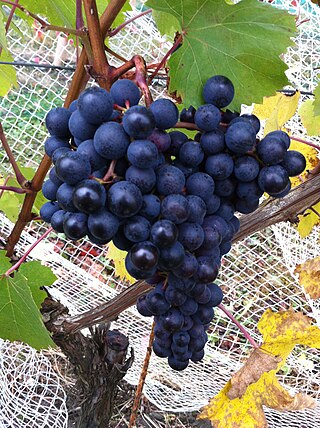
Dolcetto is a black Italian wine grape variety widely grown in the Piedmont region of northwest Italy. The Italian word dolcetto means "little sweet one", but it is not certain that the name originally carried any reference to the grape’s sugar levels: it is possible that it derives from the name of the hills where the vine is cultivated. In any case the wines produced are nearly always dry. They can be tannic and fruity with moderate, or decidedly low, levels of acidity and are typically meant to be consumed within a few years after release.
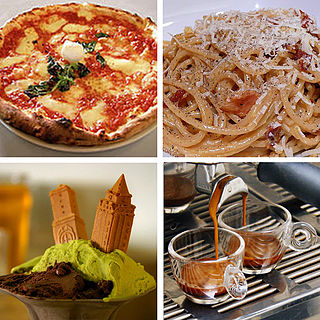
Italian cuisine is a Mediterranean cuisine consisting of the ingredients, recipes, and cooking techniques developed in Italy since Roman times, and later spread around the world together with waves of Italian diaspora. Significant changes occurred with the colonization of the Americas and the introduction of potatoes, tomatoes, capsicums, maize, and sugar beet—the latter introduced in quantity in the 18th century. It is one of the best-known and most widely appreciated gastronomies worldwide.

The cuisine of Sardinia is the traditional cuisine of the island of Sardinia, and the expression of its culinary art. It is characterised by its own variety and by the fact of having been enriched through a number of interactions with the other Mediterranean cultures while retaining its own identity. Sardinia's food culture is strictly divided into food from the land and food from the sea, reflecting the island's historical vicissitudes and especially its geographic landscapes, spacing from the coastline to the ragged mountains of the interior. The Sardinian cuisine is considered part of the Mediterranean diet, a nutritional model that was proclaimed by UNESCO as an intangible cultural heritage.
Ciambella is an Italian ring-shaped cake with regional varieties in ingredients and preparation. As an example, a basic version of the cake could be prepared using flour, baking powder, salt, eggs, milk, sugar, oil, and vanilla flavoring. Honey is sometimes added as a sweetener. To create the light texture the sugar and eggs are whisked together, and oil and milk are added while whisking continuously until the mixture is frothy. Then sifted baking powder and flour are added to the dry ingredients and the cake is baked in a ring shaped pan.

Lombard cuisine consists of the cooking traditions and practices of the Italian city of Lombardy. The historical events of its provinces and of the diversity of its territories resulted in a varied culinary tradition. First courses in Lombard cuisine range from risottos to soups and stuffed pasta, and a large choice of second-course meat or fish dishes, due to the many lakes and rivers of Lombardy.

The Valdarnese, also referred to as Valdarnese Bianca, Valdarno Bianca or Pollo del Valdarno, is a breed of large white chicken from the upper Valdarno, the valley of the Arno river, in Tuscany, central Italy. It became virtually extinct in the 20th century, but the population is recovering. It is a different breed from the Valdarno chicken, which originates in the lower part of the Valdarno, and is black.
Spongarda is a local cake originating in the comune (municipality) of Crema. The Lombardy region includes it as spongarda of Crema in the list of traditional food products.

Neccio, also called niccio, ciaccio or cian, is a galette based on chestnut flour, typical of some mountain zones of Tuscany and Emilia, in Italy, and of the island of Corsica, in France.

Christmas in Italy begins on 8 December, with the Feast of the Immaculate Conception, the day on which traditionally the Christmas tree is mounted and ends on 6 January, of the following year with the Epiphany, and in some areas female puppets are burned on a pyre, to symbolize, along with the end of the Christmas period, the death of the old year and the beginning of a new one. 26 December, is also a public holiday in Italy. The Italian term Natale derives from the Latin natalis, which literally means 'birth', and the greetings in Italian are buon Natale and felice Natale.

Ligurian cuisine consists of dishes from the culinary tradition of Liguria, a region of northwestern Italy, which makes use of ingredients linked both to local production, and to imports from areas with which, over the centuries, the Ligurians have had frequent trade.

The cuisine of Basilicata, or Lucanian cuisine, is the cuisine of the Basilicata region of Italy. It is mainly based on the use of pork and sheep meat, legumes, cereals and vegetables, with the addition of aromas such as hot peppers, powdered raw peppers and horseradish. The local gastronomy is, for historical-cultural reasons, typically peasant, based on simple recipes and on the culture of reuse, in particular of meat and bread.

Mantuan cuisine is the set of traditional dishes of the Italian province of Mantua, some of which date back to the time of the Gonzaga.

Bisciola is an Italian sweet leavened bread originating in the Valtellina Valley of Lombardy, Italy. It is typically prepared for Christmas, during which time it is an essential component of Christmas festivities.
The guasteddra dolce nissena or guastedda is a typical dessert of the city of Caltanissetta tradition. The word guastedda being a cacuminal or retroflex phoneme is written guastedda and pronounced guasteddra, it is represented with the symbol [ɖ] in the international phonetic alphabet (IPA); this phoneme is not present in the Italian language.

The ossa di morto or Dead men's bones are traditional Sicilian biscuits, included in the list of traditional Italian agri-food products (P.A.T) of the Ministry of Agricultural, Food and Forestry Policies (Mipaaf).















